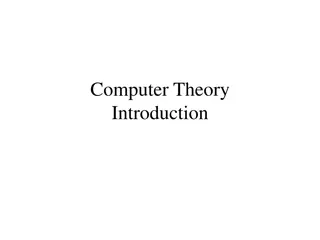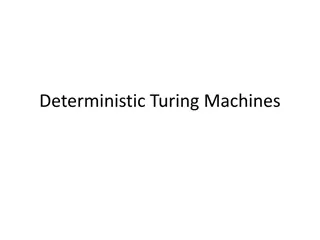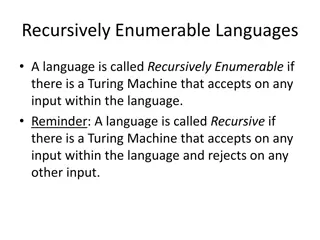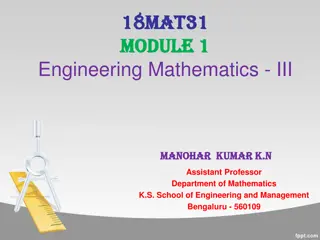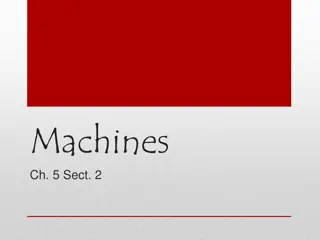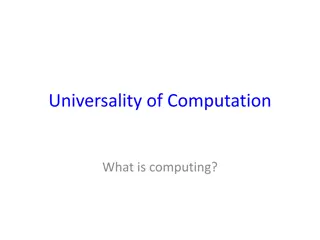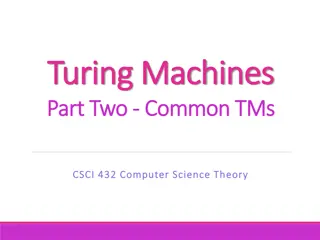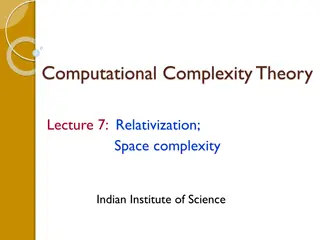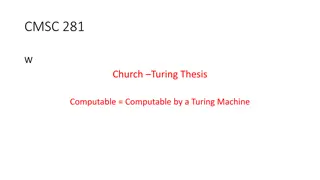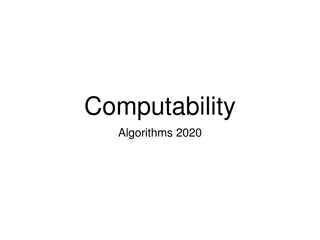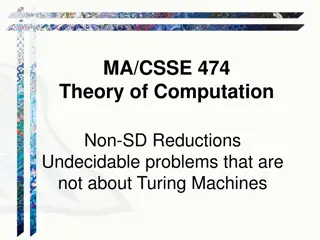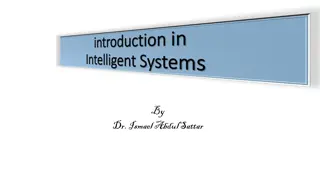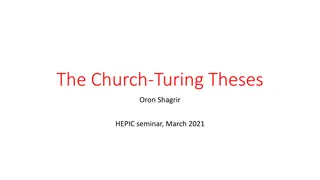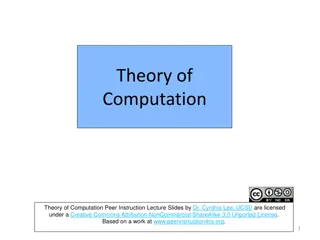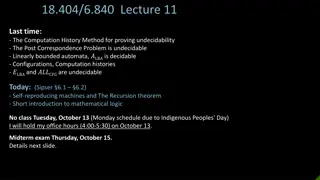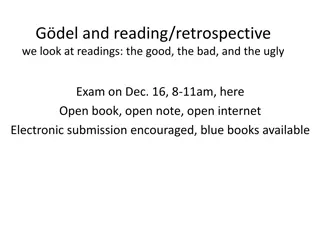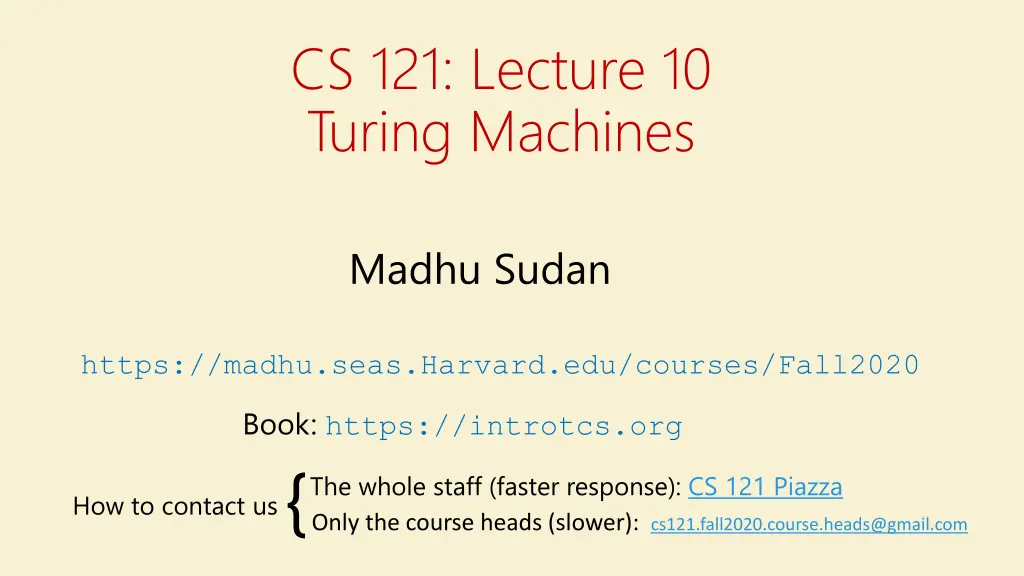
Understanding Turing Machines: Basics and Examples
"Explore the fundamental concepts of Turing Machines, including definitions, operations, and examples. Learn how these machines enable computation beyond finite automata and circuits in computer science."
Download Presentation

Please find below an Image/Link to download the presentation.
The content on the website is provided AS IS for your information and personal use only. It may not be sold, licensed, or shared on other websites without obtaining consent from the author. If you encounter any issues during the download, it is possible that the publisher has removed the file from their server.
You are allowed to download the files provided on this website for personal or commercial use, subject to the condition that they are used lawfully. All files are the property of their respective owners.
The content on the website is provided AS IS for your information and personal use only. It may not be sold, licensed, or shared on other websites without obtaining consent from the author.
E N D
Presentation Transcript
CS 121: Lecture 10 Turing Machines Madhu Sudan https://madhu.seas.Harvard.edu/courses/Fall2020 Book: https://introtcs.org { The whole staff (faster response): CS 121 Piazza How to contact us Only the course heads (slower): cs121.fall2020.course.heads@gmail.com
Announcements: Midterm 1 next week: Logistics announcement by Thursday Prep Material: Canvas Files Midterm Prep Likely: 2 pages of typset cheatsheet allowed. No other external refs. Homework 3 due Thursday Advanced Sections: Christina Ilvento on Differential Privacy!
Where we are: Part I: Circuits: Finite computation, quantitative study Part II: Automata: Infinite restricted computation, quantitative study Part III: Turing Machines: Infinite computation, qualitative study Part IV: Efficient Computation: Infinite computation, quantitative study Part V: Randomized computation: Extending studies to non-classical algorithms
Today: Definition of Turing Machines A function F not computable by DFA or Circuits Computing F with Turing Machine
Definition of Turing Machine (TM) Recall: DFA = Finite state control + input on tape + move right on each step. In a nutshell: TM = DFA + Write + Move left+right on tape (Either Write / Move left+right on its own insufficient) TM: Main change: More Involved Transition function: ? (now ?): ?: (current state, read symbol) (new state, write symbol, direction of move/halt) Explicit halting (don t just end after reading last input bit) Computes functions: output = concatenation of 0,1 symbols on tape.
Formal Definition (Barak, Definition 7.1): TM on ? states and alphabet 0,1, ,? is given by ?: ? ? Action, where Action = ?,?,?,? ?=Left, ?=Right, ?=Stay (don t move), ?=Halt (done!!) Operation: Start in state 0, Tape ? = General step: current state ? ; input symbol ?: Let ? ?,? = ?,?,? Write ? on tape (overwriting ?) ; Move to state ?; Move Head left (? ? 1) if ? = ?; right if ? = ?; don t move if ? = ?. Repeat General step until ? = ? ?0 ?? 1??? , Head (?) at ?0
TM Example { (0,0,?) if ? 0,1 Example: ? = 1; = 0,1, ,? ; ? 0,? = (0,?,?) if ? 0,1 What does TM output on 101? (in future, we won t write or ?)
TM Example { (0,0,?) if ? 0,1 Example: ? = 1; = 0,1, ,? ; ? 0,? = (0,?,?) if ? 0,1 What does TM output on 101? (in future, we won t write or ?) What function does TM compute.
A hard function ?: 0,1 0,1 , ? ? = 1 ? = 1?for ? = 2? for integer ?
Exercise Break 1 ?: 0,1 0,1 , ? ? = 1 ? = 1?for ? = 2? for integer ? (30 sec) Prove that no circuit computes f (4 min 30 sec) Prove no DFA computes f Part 1: Focus on big idea; defer calculations/parameter settings. Part 2: Get your hands dirty; do calculations+parameter settings.
F is computable by a Turing Machine Main Idea: Loop many times: Scan string left to right Replace every alternate 1 by 0; reject if number of 1s is odd and greater than 2.
More details: Alphabet & States Alphabet = 0,1, ,?,# 0. Start/Not seen any ones 1. Move Right first one 2. Move Right even # of ones 3. Move Right odd # of ones 4. Move Left 5. Clean Right and Reject 6. Clean Left and Reject
Alphabet = 0,1,,?,# 0. Start/Not seen any ones 1. Move Right first one 2. Move Right even # of ones 3. Move Right odd # of ones 4. Move Left 5. Clean Right and Reject 6. Clean Left and Reject 0 1 ? # State/Input 0 1 2 3 4 5 6
Alphabet = 0,1,,?,# 0. Start/Not seen any ones 1. Move Right first one 2. Move Right even # of ones 3. Move Right odd # of ones 4. Move Left 5. Clean Right and Reject 6. Clean Left and Reject ?: 0,1 0,1 , ? ? = 1 ? = 1?for ? = 2? for integer ? 0 1 ? # State/Input 0 1 2 3 Exercise Break 2: 4 Fill in rows for states 2 & 4 5 Keep answer ready (5 triples) to type into chat. Use D for 6
Alphabet = 0,1,,?,# 0. Start/Not seen any ones 1. Move Right first one 2. Move Right even # of ones 3. Move Right odd # of ones 4. Move Left 5. Clean Right and Reject 6. Clean Left and Reject 0 1 ? # State/Input 0 invalid (5,#,R) (1,1,R) (-,0,H) (0,#,R) 1 invalid (5,#,R) (2,#,R) (-,#,H) (1,#,R) (4,?,L) 2 invalid (5,#,R) (3,1,R) (2,#,R) 3 Invalid (5,#,R) (2,#,R) (6,0,L) (3,#,R) (0, ,R) 4 invalid (4,1,L) invalid (4,#,L) 5 invalid (5,#,R) (5,#,R) (6,0,L) (5,#,R) (-, ,H) 6 invalid (6,#,L) invalid (6,#,L)
Summary & Next Achieved today: Defined TM Shown it computes one function that DFA and circuits can t Next Lecture: More examples. Towards equivalence with (all) programs


